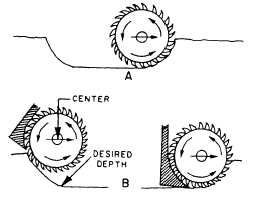Figure 9-65.—Wheel ditcher.
your machine performs. Figure 9-64 shows two examples
of teeth patterns normally used. When the teeth wear
down about one-half inch and before the face of the
bucket shows wear, ensure the teeth are reversed or
replaced.
NOTE: Always install a complete set of teeth on a
bucket when reversing or replacing teeth.
If only a few new teeth are installed here and there
along the bucket line, the new teeth will cut the most and
wear down much faster than would a whole new set.
However, if only one or two teeth show too much wear
or are broken or chipped, they may be reversed or new
ones installed in their place if the rest of them are in good
shape.
Three types of ditchers used in the NCF are the
wheel ditcher, the ladder ditcher, and the chain ditcher.
The most common ditcher is the ladder ditcher. Read the
operator’s manual to obtain detailed information on the
care, maintenance, and operation of a given ditcher.
WHEEL DITCHER
On the wheel ditcher (fig. 9-65), the digging buckets
are mounted on a large wheel. The wheel is attached to
a frame type of horizontal boom that can be raised and
lowered, and the ditcher has a spoil conveyor for
carrying the excavated material out to either side of the
machine.
To start a cut, lower the turning wheel into the
ground, and then watch the bucket teeth start to dig. As
the ditcher itself is stationary, apply enough pressure to
the buckets so they fill “heaping” without gouging deep
enough to slow the wheel.
The ditch will have a rounded beginning, as shown
in figure 9-66, views A and B. Be sure the position of
the center of the wheel is over the starting point for the
full depth of the ditch, so the ditcher has enough room
to dig down to the desired depth at the beginning of the
cut (fig. 9-66, view B).
NOTE: Before starting any excavation, you must
ensure a valid digging permit is attained that covers the
area you are tasked to ditch.
Digging
When the wheel is at the correct depth, you should
move the machine forward just fast enough to keep the
buckets reasonably full. Crowding too hard overworks
the engine and strains the digging parts without adding
to the output.
Soft rock usually responds best to a high-wheel
speed with very slow walking speed. If dirt is soft, you
may crowd it so the dirt in excess of the bucket capacity
piles on each side of the ditch without damage.
Experience will help when selecting the right
combination of digging and travel speeds for various
types of soil; however, consult the operator’s manual for
Figure 9-66.-Starting a cut with a wheel ditcher.
9-30





